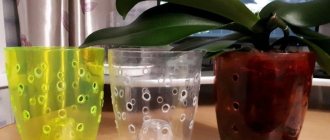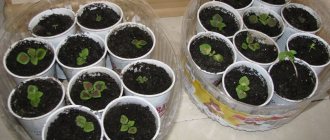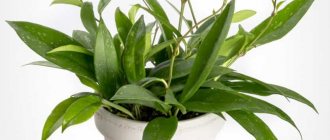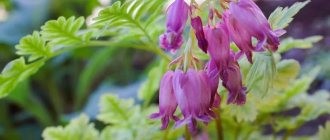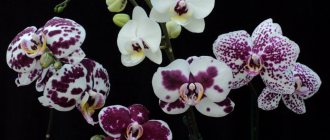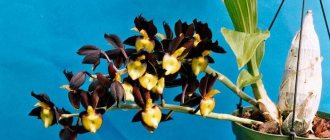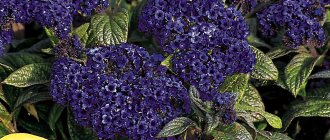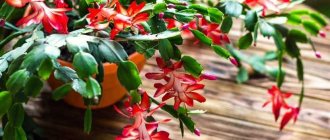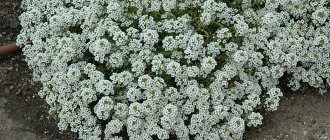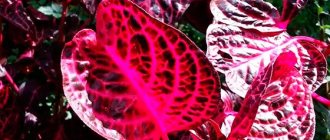Caring for clerodendrum at home
How to care for clerodendrum
For healthy growth and full flowering, tropical forest plants need conditions that are as close to natural as possible.
Clerodendrum at home prefers window sills facing south, west or east - it needs bright light, but with protection from direct sunlight. The optimal temperature in summer is between 18-25 ºC; during the dormant period, which occurs in the winter months, the plant needs coolness - no higher than 15 ºC. The air humidity in the room with clerodendrum should be high, so you will have to spray the plant with soft, settled water every night in the warm season, and in winter, remove the flower pot away from heating appliances.
Clerodendrum should be watered abundantly with soft water, but the top layer of soil should dry out between waterings. During the dormant period, soil moistening is carried out according to the following principle: the cooler it is in the room, the less often we water it, but the earth ball should not dry out completely. From mid-spring to the end of summer, clerodendrum is fertilized twice a month with complex fertilizers for flowering indoor plants; no fertilizing is needed in autumn and winter.
Clerodendrum flowering
Depending on the species, clerodendrum begins to bloom in June, and these plants fade in September. It is interesting to observe how white bracts appear on the still bare shoots of Thompson's clerodendrum in early spring, from which crimson corollas up to 2.5 cm in diameter are formed. The beautiful clerodendrum blooms from June to September with panicles of purple flowers, and the fragrant clerodendrum blooms almost all year round. Anyone who has seen clerodendrum bloom will definitely want to see this magic again.
Pruning clerodendrum
Caring for clerodendrum involves mandatory annual pruning of the plant at the beginning of the period of active growth. Caring for Thompson's clerodendrum, for example, in addition to removing dried or weak branches, requires shortening all shoots by a third of the length, which should stimulate abundant flowering, as well as intensive growth and branching of young side shoots, on which inflorescences are formed. Clerodendrum is also pruned in order to form a crown - if you want the clerodendrum to grow as a bush, you need to greatly shorten the shoots when pruning in spring, otherwise you will have to install support for them later.
How to prune clerodendrum to make a tree? The standard form is created as follows: all shoots are removed, except for one, the strongest, which is cut off at a height of 50-70 cm, and then all shoots that appear in the apex area are pinched in order to create a crown due to their branching. If sprouts appear on the stem below the crown, they are removed.
Clerodendrum transplant
Growing clerodendrum requires replacing old soil with new soil from time to time; in addition, an overgrown plant may require a larger pot. Plants are replanted at the beginning of active growth after pruning. Young plants need annual replanting, but older plants need to change the soil and pot once every two to three years. The soil for clerodendrum should be nutritious and slightly acidic (pH 5-6). You can use store-bought soil, adding sand to it, or make your own from peat, coarse sand, leaf and clay soil in equal parts.
Before replanting the plant, the new soil must be disinfected by steaming, oven or microwave. How to transplant clerodendrum? Take a pot 2 cm in height and 2 cm in diameter larger than the old one, place a layer of drainage three centimeters high in it and transfer the plant from the old pot to the new one, being careful not to damage the root ball. Add the required amount of new substrate to fill the voids in the pot and water the plant. If your clerodendrum needs support in the future, dig it in when replanting so that you don’t have to stick it into the pot later, damaging the roots of the plant.
Clerodendrum propagation methods
Clerodendrum can be propagated by seeds and cuttings.
Propagation by seeds
Seeds are sown at the end of February or at the beginning of March. The container is filled with a substrate, which consists of sand, turf soil and peat, on top of which the seeds are laid out. The container is covered with glass and transferred to a bright place. Crops should be regularly ventilated and the surface of the soil mixture should be moistened in a timely manner.
After about 6–8 weeks, the first shoots will appear. When the seedlings have formed 4 true leaves, it is necessary to pick. The seedlings are planted in individual small cups with a diameter of 6 cm. When the plants take root and begin to grow, they will need to be gradually adapted to conditions suitable for adult plants.
Cuttings
After pruning the bush, you can prepare cuttings. In the warm season, roots appear on cuttings easily. It is necessary to root cuttings in water. Once they have taken root, they should be transplanted into separate containers with a diameter of about 7 cm, and then covered with a transparent plastic cap. It is important that the surface of the soil mixture is moist at all times.
When the root system of the cutting is finally formed, new stems and foliage will appear, it, together with a lump of earth, should be transferred to a new container with a diameter of about 9 cm, in which Clerodendrum will grow until spring. After a year, the bush must be replanted by transferring it into a larger container, reaching 11 centimeters in diameter, but the same soil mixture is used. During this year, the stems on the bush need to be pinched at least 2 times, this will make the flowering more luxuriant.
Types of clerodendrum
In total, more than 300 varieties have been registered in the genus, but not many are used in indoor floriculture.
Clerodendrum of Mrs. Thompson (Thompson). The most popular species is a deciduous woody vine with thin, smooth shoots. Dense dark green foliage grows up to 12 cm in length. The leaf blade, swollen between the veins, has an oval shape with a pointed end. In March-June, loose clusters on long peduncles rise above the vegetation. White, bell-like bracts surround small scarlet buds. Long white or cream stamens protrude from the center. Externally, the flower is very similar to a moth with long antennae.
Mrs. Thompson's clerodendrum
Clerodendrum Ugandan. The evergreen vine grows shoots up to 2 m in length. They are covered with broadly lanceolate dark green leaves, between which grow loose panicles with small bluish-purple flowers. The stamens on these flowers are especially long and blue. The lower petal is enlarged and has a darker shade. The variety requires brighter lighting and abundant watering.
Clerodendrum uganda
Clerodendrum brilliant. An evergreen shrub with long climbing stems. The leaves on it grow oppositely or in whorls of 3 pieces. The almost rounded leaf blade reaches 8 cm in length and 6 cm in width. The edges of the leaf are wavy, the base resembles a heart. Short flower stalks with dense clusters of scarlet-red buds grow from the leaf axils. In favorable conditions it blooms all year round.
Clerodendrum brilliantus
Clerodendrum Wallich (Prospero). Large, dark green, oval-shaped leaves grow on long, flexible, reddish-green branches. Their length is 5-8 cm. Large inflorescences with snow-white flowers bloom between them. The bush itself is quite compact, but capricious. It needs long daylight hours and high humidity.
Clerodendrum Wallich
Clerodendrum philippines. This variety, still rare for our country, is distinguished by an intense aroma of flowers, in which notes of vanilla and jasmine are mixed. In the evening the smell intensifies. A dense corymbose inflorescence blooms on a long peduncle. The buds look like tiny (up to 3 cm in diameter) roses. The width of one inflorescence reaches 20 cm, so it really resembles a bouquet. The shoots are covered with dark green velvety leaves of a wide oval shape. Flowering begins in the second year of life.
Clerodendrum philippines
Clerodendrum bunge. The Chinese species grows especially quickly. The plant grows light green, broadly oval leaves, which are collected in whorls. Beautiful spherical inflorescences of small pink buds bloom on the stems. From a distance the flower looks like fireworks. Flowering continues all summer.
Clerodendrum bunge
Clerodendrum speciosum (the most beautiful). A spreading bush up to 3 m high consists of branched tetrahedral shoots. This evergreen plant is covered with large, heart-shaped leaves with short, soft hairs. They grow on reddish petioles. From June to September, purple inflorescences with a darker, lilac-red corolla are pleasing.
Clerodendrum speciosum
Clerodendrum inerme (unarmed). An evergreen shrub with long vines is covered with oval emerald leaves with a raised central vein. It blooms with white, moth-like flowers with long purple stamens. An interesting variety is inerme variegated. It is distinguished by lighter (light green) spots on the leaves, which create an exquisite marble pattern.
Clerodendrum inerme
Clerodendrum Schmidt. The shrub or small tree is distinguished by dense shoots and bright green oval leaves with a wavy edge. During the flowering period, many brushes are formed on drooping peduncles. They bear snow-white flowers. They exude a pleasant sweetish aroma.
Clerodendrum Schmidt
Botanical description
Philippine clerodendrum (Clerodendrum philippinum), or the second name Volkameria fragrant, belongs to the genus Clerodendrum of the Lamiaceae family. This is a low, up to 2 m in height, evergreen bush. Its natural habitat is Asia and countries with a tropical climate. Most often it grows in the forests of China, Japan, China, as well as in Mexico and Congo.
Leaves and shoots
The leaves are large in size, reaching an average of about 15-16 cm, rich green or light green in color. The leaf is heart-shaped, wide, with a jagged edge. The leaf blade has small tubercles, terry, the veins are clearly visible. According to the method of attachment to the stem, they are long-petioled and arranged oppositely. The shoots are long, smooth, directed upwards.
Flowers
Small, 2-3 cm pink-white flowers, which are collected in dense corymbose inflorescences, are located at the top of the clerodendrum. The flower has 5 petals. The size of the inflorescences ranges from 16 to 22 cm in diameter. The corolla is shaped like a funnel.
With proper care and comfortable conditions, clerodendrum will delight you with its flowering almost all year round.
Photo
Here is what the plant looks like.
Reproduction
The plant can be propagated in two ways:
By cuttings
It is considered the easiest way. This breeding option is carried out in the spring. The apical part of the stem with 3-4 internodes is cut off from the main bush.
For rooting, planting material is left in a glass of water or in a special substrate. To speed up the process, the plant can be covered with transparent polyethylene. The temperature should remain above twenty degrees Celsius.
Seeds
This method is a little more complicated than the previous one, but no less effective. Seeds are planted in February - March in containers with substrate and covered with film. In this way, greenhouse conditions are created.
To avoid stagnation of moisture, the seeds must be watered and ventilated periodically. Also, seedlings should have good lighting.
After two months, the first sunrises will appear, and when they grow four leaves, they are transplanted into small containers. After good rooting, the seedlings are moved to larger pots and accustomed to new conditions.
Transplantation and propagation, pruning
Clerodendrum requires annual replanting into fresh soil. But the slightest damage to the root system leads to flower disease. Therefore, transplantation is carried out very carefully and only by transshipment.
The new pot should be 1-2 cm larger than the previous one. A drainage layer of fine expanded clay 3 cm thick must be laid on its bottom.
Clerodendrum philippines is successfully propagated by apical cuttings .
This is the easiest way to quickly obtain young plants. In early May, cuttings with 3 internodes are cut from the overgrown mother bush. They can be rooted either in water or in damp sand or perlite, covered with a glass jar on top. After rooting, young plants are planted in separate pots. Clerodendrum is pruned annually in mid-April. This procedure consists of shortening the shoots of the plant by 1/3.
After this, the bush begins to actively branch and grow new shoots.
Very soon buds and flowers form on them. The flowering of the plant depends on the number of young shoots, since buds are formed only at their tops.
Description
Clerodendrum (lat. Clerodendrum) is a liana-like or shrub plant characterized by lush and long-lasting flowering. Translated from ancient Greek, the word “clerodendrum” is translated as “tree of fate,” and the entire history of the species is shrouded in many beliefs and legends. For example, the natives of the island of Java believed that a donated branch of a plant could dramatically change a person’s destiny, giving him some important chance.
Among the ancient Romans, volkameria was considered a love amulet and was presented as gifts to the goddess Venus, being the main decoration of her temples. In European countries, the peak of popularity of clerodendrum occurred in the mid-19th century, when the plant began to be actively grown in greenhouses and flower beds. A little later, it became the object of close attention of breeders, who, by crossing different species, obtained a large number of beautiful varieties.
Clerodendrum is a member of the Lamiaceae family and is found in the natural environment in the tropical regions of Asia, Africa and Latin America, as well as on the islands of the Indian Ocean and Australia. Among the wide variety of species, there are both evergreen and deciduous forms, while vines can reach 4 m, and shrubby representatives of the genus grow up to only two. The tetrahedral stems of the plants have smooth olive or red-brown skin and are covered with opposite petiolate leaves of bright emerald color. The shape of the leaf blades depends on the plant variety and can be heart-shaped, oval or ovoid. The length of the leaves varies from 8 to 20 cm, and the edges can have a solid or finely toothed structure. The surface of the plates has a clear veining with clearly visible depressions along the central and lateral veins.
8 photos
The inflorescences of clerodendrum consist of small and very beautiful flowers, located in the tips of the shoots or leaf axils and have a corymbose or paniculate type of structure. Thanks to their long peduncles, they look very elegant and look like lush bouquets. The calyxes are bell-shaped and divided into 5 lobes, and their diameter can reach 2.5 cm. The corolla is painted in contrasting colors, and long and thin stamens grow from its middle, often reaching 3 centimeters.
The flowering period for most volkameria lasts from April to September and is accompanied by a very pleasant aroma. Moreover, not only flowers smell, but also leaves, and each type has its own unique smell. The bracts of clerodendrum are quite large and remain on the bush until dormant, giving others the impression of constant flowering. After flowering, most plants produce orange fruits that are oblong, reach 1 cm in length and contain one single seed.
What is clerodendrum
The name of the plant is translated from Greek very simply: kleros - “fate”, and dendron - “tree”. This plant became popular in the 19th century, when tropical galleries and winter gardens were in great fashion among aristocrats. Climbing woody vines could be used as living partitions or a beautiful vertical backdrop.
The plant belongs to the Verbena family, known for its beautiful flowering. In addition, our hero is famous for its delicate aroma, which intensifies in the evening.
Some species are quite easy to care for and can even be grown in the yard in well-lit areas. For example, the beautiful clerodendrum, which is sometimes called sea, grows even on the southern coasts, not afraid of the burning rays of the sun and salty splashes of water.
But it would be more correct to say that this is a rather capricious flower that is not so easy to grow correctly in an apartment or house. It is equally demanding on lighting, humidity, watering, temperature; in general, if you want such beauty to live next to you, you will have to follow some rules. Until recently, only a couple of varieties of clerodendrum were available to our flower growers, but now their range is very wide, so the plant is gaining popularity again. Isn't this a reason to study in detail the principle of growing an exotic beauty?
This plant is native to the tropical regions of Asia, South America and Africa. In the wild, at least 400 varieties are known; they are found in the form of trees, shrubs or vines, and can be evergreen or deciduous. In addition to the lush, beautiful flowering, this plant has one more feature: its branches are very flexible, but become woody over time. This will allow you to give the crown any shape that your imagination suggests.
The most common varieties
Among the many varieties of the tree of fate, it is worth highlighting several of the most beloved by our flower growers for their relative ease of care and visual effectiveness. Let's look at them in more detail:
- Mrs. Thomson's clerodendrum (Clerodendrum thomsoniae). It has thin, smooth shoots with a high growth rate. With age, the vine trunk becomes covered with dense woody bark. It is a deciduous plant and most often sheds most of its leaves in the winter. Clusters of inflorescences consist of white, heart-shaped flowers with bright red corollas. The leaves are large, juicy green in color, oblong, pointed in shape, and can reach 12 cm in length. Mrs. Thomson's Volcameria grows very quickly when grown indoors, flowering time is from March to June inclusive.
- Clerodendrum splendens. An evergreen non-deciduous shrub with liana-like shoots. The leaves are almost round in shape, up to 6 centimeters wide, about 8 cm long, with a heart-shaped base, wavy edges and an oblong apex. Corymbose and racemose inflorescences, located in short axils, are collected from red scarlet flowers. With proper care, it will delight you with brilliant blooms all year round.
Varietal diversity in the photo
Seasonal growing conditions - table
| Spring | Summer | Autumn | Winter |
| Lighting | Well-lit areas of the room with the possibility of shading from direct sunlight. The best place for growing is on east and west windows. | You can move it to a south window or provide additional lighting. | |
| Temperature | +18…+25 °C | +15…+18 °C | |
| Air humidity | To ensure an adequate level of humidity, spray the plant with settled or filtered water every evening. |
|
|
| Watering | Abundant, only with settled water. The top layer of soil in the pot should dry out between waterings. | Moderate, as needed. Do not allow the earthen ball to dry out. |
|
Among other things, your flower may need support so that the growing vine does not fall to one side, risking falling from the window. This can be a stretched wire or twine, as well as a spacer of any convenient shape.
Pruning when forming a clerodendrum crown at home
When replanting, you can combine this process with pruning the flower shoots. Long and weak shoots are removed, and they can be pinched to give the plant a more luxuriant shape.
The formation of the crown of clerodendrum is very important, since this flower belongs to vines, its size can reach 2-3 meters, which is not always appropriate in an apartment. And only regular pruning will help maintain the shape of a decorative bush or tree.
The simplest pruning of a plant is to remove 1/3 of the length of woody shoots. This annual pruning of clerodendrum promotes abundant flowering.
When grown at home, this vine is usually given the shape of a medium-sized bush. To do this, at the beginning of spring, all shoots are cut to a size of 7 cm from the growth point. Then the plant begins to grow actively, new young shoots with leaves appear and the result is a nice flowering bush.
Luxurious clerodendrum in your home: growing, care and propagation
Surely you have seen this beautiful flower and are eager to get to know it better. The bright greenery of clerodendrum and its magnificent flowers leave no one indifferent. People call it the tree of destiny and believe that flowering brings happiness to the house and pleasant updates to life. But in order to grow a strong and healthy plant at home that will delight you with its beautiful appearance, you need to know the features of caring for it.
Difficulties in growing
Philippine clerodendrum is not sensitive to a large number of diseases and pests that a houseplant may suffer from, however, during the growing process it can be attacked by:
- spider mite;
- scale insect
To eliminate these ailments, it is necessary to carry out the following procedures:
- wash the plant under a hot shower. The water temperature should be about +45. +50°C;
- treat the flower with chemicals and insecticides.
Changes in the appearance of a plant can occur as a result of improper care:
- Lack of flowering may occur due to improper wintering of clerodendrum. For it, it is necessary to take a break from flowering, reducing watering to a minimum in winter and moving the flower to a room with a temperature of +12. +15°C for 1–1.5 months.
- The lack of new buds in the spring may occur due to the lack of proper lighting in sufficient quantities.
- Also, a flower may not bloom due to the fact that it lacks nutrition from the substrate in which it grows. Accordingly, Philippine clerodendrum needs to be transplanted into a new suitable soil.
- Root rot can cause the death of a flower. This phenomenon is possible when watering too much and the soil does not dry out enough. To save the plant, it must be transplanted into a new container, removing damaged areas of the rhizome.
- Yellowing of leaves and leaf fall are the cause of lack of watering.
Features of the variety
REFERENCE! Volkameria fragrant, or Clerodendrum philippines, is one of the 400 species of the genus Clerodendrum, distinguished from the rest by its unpretentiousness, long flowering time.
The distinctive features of this variety include velvety leaves and light pink flowers that smell sharply of jasmine. Clerodendrum philippines also differs from its fellows in that its stamens are not exposed far beyond the petals, but are securely hidden under them.
Do you want to learn about the features of keeping and proper care of clerodendrum? On our Internet portal you will find materials about other varieties of this beautiful plant: Thompson, Bunge, Ugandan, Most Beautiful, Brilliant, Wallich or Prospero, Inerma, Speciosuma.
Clerodendrum - a flower for a good mood
It is interesting that clerodendrum began to be grown as an indoor flower relatively recently, acquiring the well-deserved love of flower growers
Interior designers also did not ignore this touching and delicate plant. It looks great in winter gardens and interiors with a touch of romance.
They say that contemplating its flowers not only brings aesthetic pleasure, but also gives thoughts a positive attitude, relieves stress and excessive irritability. I confirm!
The plant has several popular names, for example, “innocent love” or “volkameria”. At first it seemed strange to me that the main nickname was the “tree of fate,” although in structure my clerodendrum is a pronounced liana. It needs support and space, then flexible branches with dark green embossed leaves can stretch up to 3 meters.
I have Thompson's clerodendrum (Clerodendrum thomsoniae) growing, and my friends' Philippine one has taken root quite well. Having become interested, I learned that there are also tall species that fully justify the word “tree” in the name:
- most beautiful;
- fragrant;
- Ugandan.
All types of clerodendrum have a subtle, pleasant aroma with a unique shade, which is attributed to antidepressant properties.
Clerodendrum has several popular names, for example, “innocent love” or “volkameria”. onlineplantguide
Brief description of cultivation
- Bloom . It starts in June and ends in the first weeks of autumn. Flowering of fragrant clerodendrum is observed almost all year round.
- Illumination . Bright but diffused light is needed (windows of western or eastern orientation, while the bush on the southern windowsill must be shaded).
- Temperature regime . During the growing season and flowering, the temperature should be from 18 to 25 degrees, and during the dormant period - from 13 to 15 degrees.
- Watering . It should be plentiful. The soil mixture is moistened after its surface has dried.
- Air humidity . She must be tall. To do this, in spring and summer, moisten the bush every evening with a spray bottle, and in winter, remove it away from heating appliances.
- Fertilizer . Feeding is carried out from the second half of spring until the last days of summer regularly once every 15 days. To do this, use a mineral complex fertilizer for flowering plants.
- Rest period . When flowering ends in the autumn-winter period.
- Trimming . At the very beginning of active growth.
- Transplant . The plant is replanted at the beginning of the growing season. While the bush is young, it should be replanted regularly once a year, and an adult plant - once every 2 or 3 years.
- Reproduction . By cuttings and seed method.
- Harmful insects . Whiteflies, aphids and spider mites.
- Diseases . Rot and chlorosis.
Diseases and pests
Clerodendrum has excellent immunity and rarely gets sick. Therefore, developmental anomalies are more often caused by errors in care than by infectious diseases. Below is an overview of the most common problems, as well as possible causes and solutions.
- If clerodendrum leaves turn yellow and wither, then the problem is most likely due to insufficient watering. In this case, it is recommended to carefully trim the yellowed foliage and switch the plant to a regular moisture regime.
- If the leaves, along with the buds, dry out and fall off, then the reason may lie in the excessive dryness of the room air. To eliminate it, it is recommended to use humidifiers and spray the plant more often.
- If the leaf blades are covered with brown spots, it is most likely a sunburn. In this case, it is necessary to either shade the plant or create diffused light for it. This can be done using gauze or a tulle curtain stretched over the window.
- A large distance between two adjacent internodes and a bare stem are often the result of insufficient lighting. In such cases, it is recommended to place the plant closer to the sun or organize additional illumination with a phytolamp.
- A long absence of flowering is often caused by improper organization of the dormant period or unbalanced feeding. To make the plant bloom, replanting it in a fresh substrate and obligatory sleep during wintering will help. To do this, from the second half of October, the flower is transferred to a cooler room and watering is reduced. Some species completely shed their foliage at this time, which should not cause concern: after a winter rest and spring pruning, the plant will quickly increase its green mass and become even more beautiful.
- Chlorosis, the main symptoms of which are a decrease in color intensity, the appearance of yellowness and a change in the shape of leaf blades, is often the result of a lack of one or another microelement in the soil. The disease is not fatal and can be easily cured by applying a complex of mineral fertilizers.
- Powdery mildew is often the result of watering with very cold water, so for moisturizing you should use only liquid warmed to room temperature.
As for pests, clerodendrum is most often attacked by whiteflies, scale insects and spider mites. The reason that contributes to their appearance is too dry air in the room. You can completely get rid of insects using modern insecticides. It is recommended to carry out the treatment in two or three passes, taking a week break between them.
If it is not possible to purchase special medications, then you can try traditional methods. To do this, clerodendrum is watered with infusion of onion or garlic. Most pests cannot tolerate their specific smell and leave.
To learn how to grow clerodendrum, watch the video below.
Care errors and their elimination
Common problems when growing clerodendrum and how to eliminate them:
| Problem | Causes | Solution |
| Dropping leaves | Lack of moisture, dry air, nutrient deficiency | Spray more often in the spring-summer period, ensure sufficient watering, remove from heating devices, replace the soil, fertilize regularly |
| Yellowing and lightening of leaves | Poor lighting or exposure to direct sunlight, hard water for irrigation | Place under bright, diffused light, water only with soft, settled water. |
| Stretching shoots, shredding leaves | Lack of light | Move the flowerpot to a well-lit place |
| No flowering | Soil depletion, excess nitrogen fertilizer, unsuitable dormant conditions, pot too large | Replant into new soil as needed, regularly apply suitable fertilizers, phosphorus and potassium stimulate flowering, take a pot for planting 2-3 cm larger than the root system |
Kinds
The clerodendrum genus includes many species and varieties
But not all of them are suitable for breeding at home. Three types are considered the most popular.
Thomson's clerodendrum (Clerodendrum thomsoniae)
Clerodendrum thomsoniae
Thomson's clerodendrum (Clerodendrum thomsoniae)
It is also called Mrs. Thompson's clerodendrum. The variety has the appearance of a vine with smooth thin stems. The leaves are dark green, with clear veins and smooth edges, up to 12 cm long.
There are inclusions of darker or lighter shades on the leaf plate. Snow-white flowers with a scarlet corolla form small tassels and bloom from early spring to June.
The plant quickly increases in size in apartment conditions and rarely complains about its health.
Clerodendrum splendens
Clerodendrum splendens
Clerodendrum splendens
The variety is presented in the form of a shrub with climbing stems. The leaves are almost round, with a pointed tip and a wavy edge. Length – up to 8 cm.
Axillary inflorescences form red racemes. Flowering lasts almost all year round.
Philippine clerodendrum (Clerodendrum philippinum)
Clerodendrum philippinum
Philippine clerodendrum (Clerodendrum philippinum)
Another variety with an unpretentious character. Philippine clerodendrum is one of the most fragrant: the aroma of the plant combines notes of vanilla and jasmine. The smell is especially noticeable in the evenings. The leaves of the plant are dark green, and the flowers are white with a pinkish tint, the inflorescences are large.
Popular varieties also include:
- Ugandan Clerodendrum, or Blue Butterflies (Clerodendrum ugandense)
- Clerodendrum wallichii (Prospero)
- Fragrant clerodendrum (Clerodendrum fragrans)
- Clerodendrum bungei
- Clerodendrum schmidtii
- Clerodendrum speciosissimum
- Clerodendrum Paniculatum
Making vertical beds with your own hands: the best ideas of 2018. For vegetables, berries, herbs and flowers (65+ Photos & Videos) + Reviews
Description and biological features
Clerodendrums grow in the wild in tropical latitudes of Asia, Latin America, and Africa. These plants are valued for their decorative properties, thanks to their bright green dense foliage, flexible shoots, and most importantly, for their abundant flowering.
Clerodendrum flowers are collected in inflorescences in the form of panicles, brushes, corymbs; many species have a wonderful delicate aroma. For example, the evergreen clerodendrum is fragrant, with white and pink fragrant flowers, capable of blooming intermittently throughout the year. Or the fast-growing Clerodendrum Ugandan, its blue and purple petals with elongated stamens look like delicate butterflies.
Features of planting and care
Reviews from flower growers about the nature of the flower are positive: caring for it is easy
Clerodendrum grows in the tropics and subtropics - in humid and warm climates. Therefore, it is advisable to provide similar conditions at home for its comfortable growth.
Temperature
For catharanthus, a comfortable temperature will be 25 degrees in summer and 15 degrees in winter.
The tropical plant prefers warmth, especially during the growing season, when it is actively developing or blooming. It should be grown at an air temperature of +20-25°C.
And in winter, the flower must rest, so temperature readings should not exceed +15 degrees. Only in this case will normal formation of buds for future flowers occur.
Lighting
Growing on a windowsill
Clerodendrum loves the sun and bright, but diffused light. If there is a lack of light, it will begin to lose leaves.
It is better to protect the plant from direct sunlight
This is especially important if you place the plant on a south-facing window: the midday sun can leave burns on the leaves, damage delicate petals, and reduce flowering
It is better to choose a window sill of an east or west window.
Optimal humidity
Flowering plant
Clerodendrum requires plenty of watering, especially in summer. You should not water too often: you need to wait until the top layer of soil in the flower pot dries out.
In winter, watering is determined by the air temperature in the room. If you manage to lower it to the recommended levels, watering is done rarely, just so that the earthen ball does not dry out. If the temperature is slightly lower than it was during the growing season, watering is reduced only slightly.
The tropical guest loves moist air. It is necessary to spray the leaves and stems daily in the summer. It is better not to direct streams of water from a spray bottle onto the flowers. Water for irrigation and spraying must be soft and settled for at least 24 hours.
In winter, indoor air is greatly dried out by heating devices. Spraying in this case is not enough. Place wide bowls of water in the room or buy an air humidifier.
Top dressing
Phosphorus-potassium fertilizer
From spring to autumn, clerodendrum requires fertilization. Feed on average once every 10-14 days. No fertilizing is needed in autumn and winter.
For clerodendrum, alternating mineral fertilizers with organic fertilizers is suitable. Fertilizers for flowering indoor plants are sold in flower shops.
Among mineral fertilizers, Agricola is recommended; Fertilize the plant according to the instructions. Organic fertilizers are also necessary to enrich the soil and improve its bioactivity. You can purchase the drug FlorGumat. Fertilizers are applied by spraying the foliage or directly into the soil so that they penetrate into the root system.
During flowering, clerodendrum needs increased phosphorus content
Pay attention to the composition of the purchased products
DIY Christmas tree decorations: beautiful, original, with soul! Master classes and step-by-step instructions | (75+ Photo Ideas & Videos)
Growing conditions
Creating favorable conditions for Philippine clerodendrum promotes constant, year-round flowering of the plant, with the exception of short-term breaks, which do not occur often, but end in even more lush color.
Placement and lighting
Choosing a place to grow this shrub is a very important moment, since it significantly affects the life of the plant. Clerodendrum is a very light-loving plant, and it needs to feel the warmth of the sun at least 10 hours a day.
Lack of light can affect:
- growth of a decorative flower - it will begin to stretch in length;
- flowering - it will be less intense and abundant.
To correct this situation, additional lighting should be used, which will compensate for the insufficient amount of natural sunlight. To do this, clerodendrum is placed under fluorescent lamps, but under scattered rays - 3–3.9 thousand lux.
When choosing the cardinal direction where Philippine clerodendrum will feel optimal, the following factors should be taken into account:
- the eastern and western sides are the best location for this decorative look;
- northern - does not have enough light;
- The south side provides sufficient access to sunlight, but their direct influence on the plant can be too aggressive, so it is necessary to create diffused radiation for it, making a light shadow.
Important! From direct sunlight, the delicate leaves of Philippine clerodendrum can be severely damaged and burns will appear on them.
Temperature
The plant cannot be called heat-loving: it prefers moderate temperatures, without jumps or changes. The optimal solution for constant flowering is to maintain the temperature at the same level throughout the year: at +18...+25°C.
If it is not possible to provide a 10-hour sunny day, then it is necessary to reduce the temperature in the room where the Philippine clerodendrum grows. This will preserve the attractive appearance of the plant, preventing it from intensively growing with scanty flowering.
Air humidity
The moisture content in the air should be moderate. On the one hand, too dry air in winter due to the use of heating negatively affects the development of clerodendrum. On the other hand, dampness in the room is also unacceptable. To create an optimal humidity level, the following measures should be taken:
- moisten the plant with a spray bottle daily during the heating season;
- water for watering and irrigation should be at room temperature, but not cold.
How does it reproduce
The flower reproduces in two ways.
Seeds
To propagate the plant, you can use seeds taken from another domestic clerodendrum flower or, if it is not available, buy it in a specialized store. The breeding procedure is complex and can cause a lot of trouble, and the resulting plant may not retain its species characteristics.
Seeds must be sown in a microgreenhouse in late winter - early spring. The first step is to fill the container with a mixture of turf, river sand and peat, then sow the seeds evenly over the surface of the ground.
Important! Crops need constant lighting. With proper care of the crops (timely watering and regular ventilation), the first shoots will appear in 1.5-2 months. After four full sheets have been formed, they should be planted in cups 6 cm in diameter.
Up to three sprouts can be planted in 11cm pots
With proper care of the crops (timely watering and regular ventilation), the first shoots will appear in 1.5-2 months. After forming four full sheets, they should be planted in cups 6 cm in diameter. Up to three sprouts can be planted in 11cm pots.
Cuttings
When propagating clerodendrum from cuttings, you should remember that hardened and lignified shoots will germinate faster than green ones. The cuttings should be placed in water or moist soil mixture, providing room temperature and good lighting. To prevent the branches from drying out, they are covered with polyethylene. As soon as roots appear and new leaves grow, the plant can be replanted.
Clerodendrum cuttings
Diseases, pests and treatment of Philippine clerodendrum
Clerodendrum Philippine is disease resistant. However, some still cause trouble:
- Root rot occurs as a result of excessive watering, and the plant becomes lethargic and depressed. It is necessary to remove it from the pot, wash the roots, remove the affected areas, sprinkle with crushed charcoal, plant in new soil and continue to follow the watering norm.
- Chlorosis (a sign of yellowed leaves) appears due to watering and spraying with unprepared, hard water. For water procedures, you should use only warm, settled and soft water. It is recommended to apply iron-containing preparations in the fall or winter - Ferovit, Ferrilen, Antichlorosis.
Chlorosis
As a rule, a plant has an unhealthy appearance precisely because of poor care. Based on various manifestations, you can guess what is disrupting its vital functions:
- leaves turn yellow and fall off - lack of moisture (you need to water more and more often);
- leaves become covered with yellow spots - sunburn (the plant should be shaded), also leaves become covered with spots due to drafts and cold air (move the pot to another place);
- leaves and flowers fall off – low humidity (spraying required);
- leaves become smaller and smaller - low light and nutrient deficiency (you need to ensure optimal lighting and regularly fertilize);
- flowering does not occur - keeping in too warm conditions during the dormant period, deficiency or excess of nutrients, if the plant has not been replanted for a long time (during the dormant period, the air temperature should be reduced, fertilizing should be carried out in accordance with the instructions, do not forget about timely replanting) .
Pests include spider mites, aphids, whiteflies and scale insects. If they or traces of their presence (cobwebs, mucus) are found, then it is necessary to immediately wipe the plant with a soapy sponge (you can also try to brush off the scale insects) and treat it several times in accordance with the instructions with Actellik or Fitoverm.
It will also be interesting: Aphelandra - caring for a houseplant at home?
Landing
Before planting or replanting clerodendrum, it is necessary to prepare nutritious soil. To do this, mix leaf humus, clay soil, river sand and peat in equal proportions, or purchase a ready-made substrate in the store. When preparing the mixture yourself, the main thing is not to “overdo it” with peat, since clerodendrum requires slightly acidic soil with a pH level of 5 to 6.5 units. The purchased soil has already undergone the necessary processing and is completely ready for use, but the homemade composition must be thoroughly disinfected.
To do this, the mixture is cleaned of small mechanical debris and vegetation residues, after which it is spread in a thin layer on a baking sheet. Then heat the oven to 200-220 degrees and place the earth in it for 20 minutes. If it is not possible to use the oven, then you can use the following method: pour some water into a pan and stretch a soft, permeable cloth over it. Then a thin layer of substrate is poured over the material and the fire is turned on. After the water boils, the soil is left to be disinfected for 10-15 minutes, then removed and a new portion is poured in its place.
Transplantation of adult individuals is carried out in the spring - as soon as the plant comes out of dormancy and prepares to actively increase green mass. The procedure is carried out as needed, when the plant has grown greatly and there is a risk of the pot overturning. To do this, choose a large, stable container that is 2-4 cm wider than the previous one, form a drainage layer of expanded clay or river pebbles at least 3-4 cm thick at the bottom, and pour a small layer of nutrient substrate.
Then, using the transfer method, the plant is moved to a new pot, while preserving the integrity of the earthen lump as much as possible. Add the missing soil along the edges and compact it lightly. The flower is placed in a calm, moderately shaded place, and after 2-3 days it is carefully moistened. Next, the clerodendrum is removed to its original place and transferred to a general care regime.
Newly purchased plants can be replanted at any time of the year. To do this, the plant is given 2-3 weeks to adapt to new conditions of temperature and humidity, and only after that they begin to replant it. To do this, shake the pot slightly and carefully separate the soil from its walls with a thin stick. Then the plant is replanted along with a lump of earth, placed in the center of a new pot and the missing soil is added.
Care
Comprehensive home care for Thompson's clerodendrum involves regular pruning and replanting. This stimulates the crop to grow shoots and grow in height. To maintain a balance between the above-ground and underground parts, it is necessary to increase the space of the pot.
Crown formation and sanitary pruning
Pruning is carried out annually. The first stage begins before wintering in mid-October. How to prune clerodendrum so that it blooms: it is necessary to remove all shoots by 1/3 of the length. By this time, the vine has already shed its leaves.
Since some vines are able to regulate the growth of branches themselves, in the spring you can find several dry shoots - they should be removed before the juices begin to flow. This type of pruning is called sanitary pruning.
The formation of the crown is also carried out in the spring to give the clerodendron the desired shape - in the form of a bush, trunk or vine. To ensure that the crop retains its tree shape, the basal shoots are trimmed and developing lateral buds are removed.
To enhance branching in the upper part of the crown, it is necessary to pinch the tops, then the side shoots will begin to grow.
Pruning promotes lush flowering. If you start clerodendrum and allow it to grow in all directions, the number of flower stalks will decrease, since all the energy and nutrients will be spent on the growth of branches. This explains why clerodendrum does not bloom at home, although the care is generally correct.
Transfer
Thompson's clerodendrum is replanted annually, since the root system quickly gains volume with proper feeding and pruning of branches. If the tips of the roots appear from the drainage holes in the pot, it’s time to select a new container.
Clerodendrum does not like the transplantation procedure and takes a long time to get used to the new soil. Therefore, the task of the gardener is to make this as less noticeable as possible for the plant.
How to transplant:
Water the plant well. Prepare the pot, lay drainage on the bottom, pour soil on top
Carefully remove the roots along with a lump of earth and transfer them to a new container. Fill the voids on the sides with soil and water them so that the soil settles.
Then fill it up again and tamp it down. You can buy ready-made soil or mix peat, loam, sand and leaf humus
There should be more loose components than clay turf so that the roots can breathe
You can buy ready-made soil or mix peat, loam, sand and leaf humus. There should be more loose components than clay turf so that the roots can breathe.
Transplantation is carried out after spring pruning to make it more convenient to handle the vine. It is better to do all procedures at the end of February - before sap flow begins in the tissues. In this case, the shoots will lose less of the nutrients accumulated since the fall.
Attention! Clerodendrum does not bloom if the volume of the root system is small relative to the aboveground part
Features of clerodendrum
The clerodendrum plant has the following features:
- The rich green leaf plates of clerodendrum are whorled or oppositely arranged, simple, heart-shaped with a rough “quilted” surface. Their length varies from 20 to 30 centimeters, and the edge can be solid or jagged. In the lower part, the flexible stems quickly become woody. The terminal racemes or corymbose inflorescences consist of very showy flowers with long stamens.
- In most species, the flowers have a butterfly shape, but in Clerodendrum benguet and Clerodendrum philippines the inflorescences look like unusually shaped bouquets.
- The foliage and flowers of most species emit a scent. Moreover, all types have a different aroma.
- The most popular among flower growers are 2 species, namely: brilliant clerodendrum and Thompson's clerodendrum. But other species are also grown at home.
- With the help of pinching and pruning, the bush can be given different shapes, or rather, bush-like, hanging or standard.
- It is not difficult to care for such a flower, as it is unpretentious and hardy, and it is also very effective and has a wonderful aroma.
Clerodendrum - secrets of care and cultivation at home. Why doesn't it bloom and the leaves turn yellow?
Peculiarities
Clerodendrum philippines is a houseplant that blooms all year round. Its flowers are pale pink or white and have a light and pleasant aroma. But if the rules for caring for such a flower are violated, flowering may slow down greatly or not occur at all. The flowers are collected in one large inflorescence. Their shape is corolla-shaped, and the buds look like small roses. Decorative varieties grow with a terry surface and beautiful openwork edges.
The length of the flower can reach no more than 2 meters. Its stems are straight, slightly drooping. The leaf blades are large and wide. They grow in the shape of a heart. Their edges are jagged. The surface of the leaves is terry with small tubercles. Their color is light green with a slight emerald tint. The veins on the leaf blades are slightly depressed.
In order for Philippine clerodendrum to develop and grow normally at home, it must be properly cared for. Although it is considered the most unpretentious to grow. First of all, you should pay attention to the following factors:
- watering;
- fertilizers;
- soil for the plant;
- temperature;
- lighting;
- pruning;
- transfer.
Watering
Philippine clerodendrum needs regular, abundant watering. But at the same time, it is not recommended to flood the plant with too much water, as this can lead to rapid rotting of the root system, which over time leads to the complete death of the flower. Regular watering should be done whenever the soil begins to dry out slightly. Moreover, it is carried out at a depth of at least 3 centimeters.
The air humidity in the room where the plant is located should not be too high. Philippine clerodendrum grows and develops well at standard humidity. If the plant is located near batteries, then it is recommended to periodically spray it with clean warm water.
This procedure is carried out only for the leaf blades of the flower. It is recommended to spray the plant in the summer. They do this to prevent the flower from drying out, which has a bad effect on its development and health.
Fertilizers
They should be purchased in specialized stores. Fertilizers are diluted with clean water according to the instructions. Remember that they should only be applied to moist soil. It is recommended to carry out such procedures no more than once every 2 weeks. For this flower, it is recommended to use liquid types of fertilizer, which are concentrated chemicals. They are applied simultaneously with watering the plant.
The soil
For clerodendrum, the best option would be a mixture of turf soil, sand, and peat. In this case, all components must be in equal proportions. The acidity of the mass should be moderate. You can also add a little humus to the mixture.
Before placing the prepared earthen mixture in a container, you should place drainage at the bottom of the pot.
Temperature
For Philippine clerodendrum, a temperate climate is considered the best option. In summer, the temperature in the room where the flower grows should be at least 20 degrees. In winter, it is permissible for the temperature to reach only 16 degrees.
If the room is too cool in winter, then you can use fluorescent lamps. Otherwise, due to severe lack of heat, the flower may not bloom. If the temperature is too high, the shoots will grow greatly.
This can ruin the beautiful appearance of the plant and weaken its health. Sudden jumps and changes in temperature can have a bad effect on the health and growth of clerodendrum philippines.
Lighting
For good abundant flowering, the plant requires a large amount of light. But it is still better to avoid direct sunlight. Clerodendrum is recommended to be grown on western or eastern windows.
But planting on the south side is also allowed if the plant is protected from solar radiation.
Watering and air humidity
Clerodendrum loves abundant watering. But the plant should not be over-watered. When water stagnates in the soil, the roots quickly rot and the entire bush dies. Therefore, you need to water regularly after the soil in the pot dries to a depth of at least 3 cm.
You should not greatly increase the air humidity in the room where clerodendrum grows. The plant does well in normal humidity. But if it is located near heating radiators, it is recommended to regularly spray its leaves with water. Water for irrigation and spraying should not be cold.
